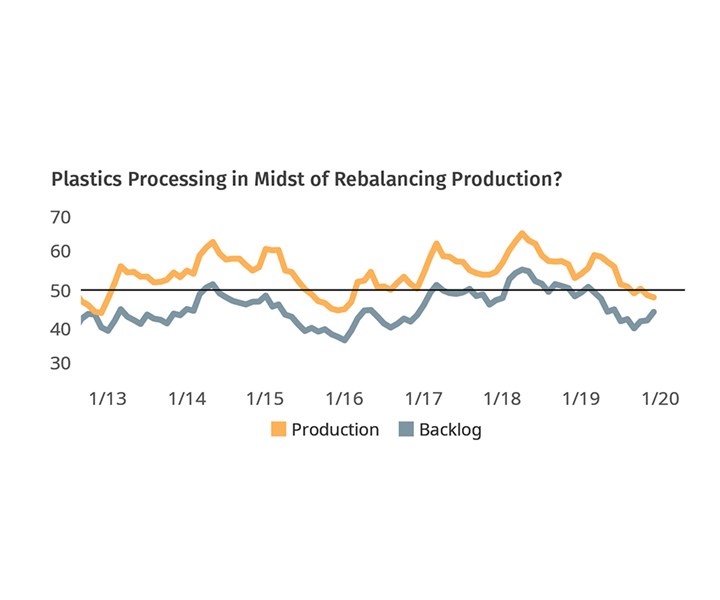Contraction Slows Among Processors
Improvement in fourth-quarter new orders suggest a production boost may be in the offing.
Gardner’s Plastics Processing Index increased marginally to 46.7 in December, indicating a slowing contraction in plastics processing business activity. (Index readings above 50 indicate expanding activity while values below 50 indicate contracting activity. The farther away a reading is from 50 the greater the change in activity compared with the prior month.)
An analysis of the underlying components of the Index for the month found that new orders, production and exports propped up the Index, which is calculated as the average of its components. The Index was bogged down by employment, supplier deliveries and backlogs. All components for the month recorded contractionary activity levels.

FIG 1 Plastics processing business activity, according to December’s survey data, pointed to a moderating rate of contraction. New orders and production posted the highest readings among all components.
Excluding October’s new orders, every index component during the fourth quarter of 2019 was contractionary. No other time in the 8-yr history of the Index has seen such a broad-based contraction.
Gardner’s Plastics Processing Index, which has reported contracting activity since July, has been a leading indicator of the U.S. Industrial Production Index for Plastics Production published by the Federal Reserve. The latest production reading reported a November decline of 1.93% vs. the same month in 2018.

FIG 2 In the last three months of 2019, new orders posted higher monthly readings than production. This may in part explain the improvement in fourth-quarter backlogs, which touched a 3-yr low in September.
The Index is based on surveys conducted each month of subscribers to Plastics Technology Magazine.
ABOUT THE AUTHOR: Michael Guckes is chief economist and director of analytics for Gardner Intelligence, a division of Gardner Business Media, Cincinnati. He has performed economic analysis, modeling, and forecasting work for more than 20 years among a wide range of industries. He received his BA in political science and economics from Kenyon College and his MBA from Ohio State University. Contact: (513) 527-8800; mguckes@gardnerweb.com. Learn more about the Plastics Processing Index at gardnerintelligence.com.
Related Content
-
How Screw Design Can Boost Output of Single-Screw Extruders
Optimizing screw design for a lower discharge temperature has been shown to significantly increase output rate.
-
Single vs. Twin-Screw Extruders: Why Mixing is Different
There have been many attempts to provide twin-screw-like mixing in singles, but except at very limited outputs none have been adequate. The odds of future success are long due to the inherent differences in the equipment types.
-
Troubleshooting Screw and Barrel Wear in Extrusion
Extruder screws and barrels will wear over time. If you are seeing a reduction in specific rate and higher discharge temperatures, wear is the likely culprit.

.jpg;width=70;height=70;mode=crop)














